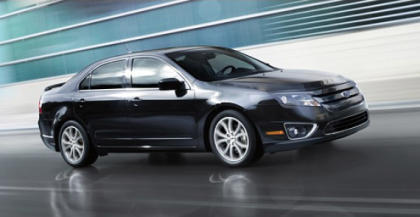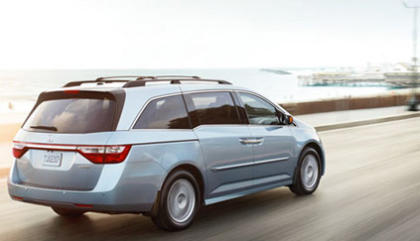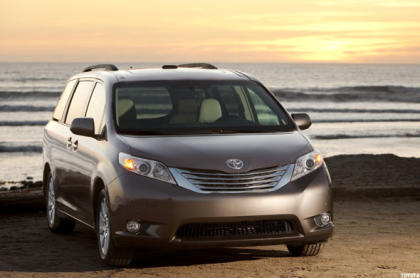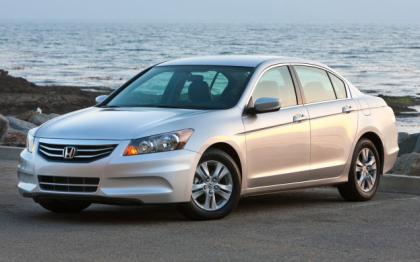Kid-friendly vehicles
How to choose the best car for your family
MORE AT CONSUMERREPORTS.ORG
Having a kid changes one’s life in lots of ways, including your automotive choices. In other words, once your baby makes the scene—along with the car seat, diaper bag, toys, and snacks that tag along in the car—you might as well bid your two-door days goodbye. So long, coupe! It was fun while it lasted.
Now it’s time to check into kid-friendly vehicles. And because needs change as your kids grow, we have divided the advice here into three categories—families with small children, families with school-age kids, and families with teenage drivers—incorporating all the things parents should keep in mind as they go about considering their next set of wheels.
You probably don’t want to take the kids along as you check out all the possibilities at dealerships, but do take them to check out your final choice. Before signing papers you want to make sure everyone fits comfortably in the new vehicle and has easy access to what they need.
Families with small children

When you have an infant or child small enough for a child restraint, car shopping means zeroing in on three things: Child safety, easy access, and cargo area, says Jen Stockburger, manager of Consumer Reports’ Vehicle and Child Safety Program.
Consider the car seat
Child safety, no surprise, has everything to do with the child car seat. Apart from the seat’s safety features and price, part of what makes a car seat the right one for you is how easily you can securely install it in your car. So, if you already own a car seat, or car seats, bring them along when car shopping so you can see if it and your car-to-be are made for each other.
Keep in mind that for your baby’s first two years, she should ride in a rear-facing infant or convertible car seat, as recently recommended by the National Highway Traffic Safety Administration and the American Academy of Pediatrics. That means the backseat of your new car will need to accommodate a seat in the rear-facing position longer. Some sedans that offer plenty of backseat room to accommodate a rear-facing convertible seat include the Nissan Altima, Honda Accord, and Chevrolet Malibu.
As for access, you want to be able to install and remove the car seat and its little passenger (who will be getting less little every day) without turning yourself into a pretzel or straining your back. Same goes for all that baby gear you’ll be toting. Wider door openings and a seat height that doesn’t require too much lifting or bending are features to look for.
If you are in the market for a car seat, see our buying advice and Ratings of every type, for the latest models.
Consider cargo capacity
How much stuff will you be lugging along?
If you plan to have just one child during the life of this car, a sedan’s trunk should suffice—one that can hold a stroller, if not a portable playpen—while larger families can choose larger vehicles such as a minivan, crossover, or SUV.
Families with school-age kids

While babies are utterly dependent on you to lug them around, school-age kids are more active and more independent. They more often get into and out of the car on their own, and they buckle and unbuckle themselves. They also bring things along in the car, ranging from tennis rackets, soccer balls, and football helmets to bikes, scooters, book bags, game consoles, and friends. “With school-age kids, you’re going from strollers to sports,” Consumer Reports' Stockburger said.
So you’ll need plenty of cargo space and, even more important, you’ll want that space to be usable and versatile. Does the rear seat fold down? If so, is it a split design that allows one side to be folded separately from the other side? For carrying extra-long items, can the front passenger seat also fold down? The Ford Fusion is one recommended sedan that has all those seat features, except for the Fusion hybrid, which does not have a fold-down rear.
If you're considering a seven-passenger vehicle with a third-row seat, check whether the third seat must be removed completely when not needed or, better, whether it can simply be folded out of the way. Two SUVs with fold-flat third-row seats are the midsized Toyota Highlander and the large Chevrolet Traverse.
Remember that cargo areas that are at waist height and trunks that don’t have a large lip that you have to lift items over are typically easier to load and unload.
Amenities

Remember life in the back seat when you were a kid? There wasn’t much to do on long trips beyond counting Volkswagens or punching your sister in the arm. Nowadays, if your budget and propensity to spoil your kids allows, you can provide pint-size passengers with a virtual theater on wheels. But first, think about the basics that will be used every day.
Stockburger advises that you look for cup holders in the backseat, especially those that can accommodate a juice box, and storage areas such as pockets in the seats, which can keep plenty of toys and books within easy reach while also keeping those items from becoming dangerous projectiles in the event of a crash.
Such features, in part, are what sold Melissa Larrey and Tracy Bouton of Falmouth, Mass., on their 2010 Toyota Sienna. As the parents of 10-year-old and eight-year-old boys, they totally appreciate the Sienna’s “seemingly everywhere” cup holders.
“It’s great that the kids can reach things and get to their own stuff,” Larrey said. “It makes such a difference.”
For older kids, Stockburger suggests considering 12-volt power ports for plugging in games and rear DVD players, which can keep your child occupied and, perhaps, prevent sibling squabbles during long drives.
For families who love music, a good sound system helps the time go by, as children can be lulled by music or can spend hours on a long trip listening to a recorded book. Some systems let your children listen to their music on headphones while you listen to yours through the speakers.
"The safety and functional aspects are most important,” Stockburger said. “But the niceties make travel enjoyable.”
Zoom with a view
Once your kid moves out of his car seat and into a booster, he can truly look out the window. And looking out that window is important, notes David Champion, director of Consumer Reports’ Auto Test Center.
"If they can't look out the window, that can trigger boredom and bickering among siblings," he said. Besides becoming bored, kids who can’t see out are more likely to suffer from motion sickness, Stockburger said.
Make sure your kids get a chance to try out the view from the backseat before you purchase the model of your choice. And if you have a child who is still using a toddler booster or booster, keep in mind while car shopping that when he outgrows the booster and is sitting directly on the vehicle’s seat, his eye level will be lower for a while than it was when he sat on the booster.
That is a big change for kids, Stockburger points out, because they’ve “dropped down from the booster seat to the actual car seat, which can be the difference between looking out a car’s door window and looking at the car’s door." "We’ve noticed that on many new vehicles, the window line rises up as it moves toward the rear of the car," she said. "This can really limit a child’s ability to see out.”
The trusty minivan

Minivans are an excellent choice for families because the windows are lower in relation to seat height, giving kids a better view out. Yes, (sigh) minivans.
“I remember thinking, ‘We are total losers now,’” Valerie Pratt De Jong, a mother of three from Charlestown, W.Va., said while laughing and recalling when she and her husband, Dan, bought their 2001 Honda Odyssey. “I remember feeling that this was one of the darkest days of our lives.”
Still, Ms. De Jong got through it: with kids 3, 8, and 10 years old, she didn’t think she had a choice. But she also points out that with three kids and three rows of seating, whichever kid ends up in the back row is there alone. Even so, De Jong says she believes she’s more bothered by that than her kids are. Indeed, what bothers her more is that in the minivan, she finds it hard to hand things to her kids or even hear them. “I just don’t like them being so far away from me,” De Jong said.
Adam Van Dale, of Tiverton, R.I., is also the father of three kids (ages 3, 7, and 9), and, as an owner of a Subaru Tribeca, also contends with three-row seating.
Because his kids’ car seats all couldn’t fit in one row, he, like De Jong, now has a lone kid in the last row who, because the seat sits so low in the Tribeca, can only talk to the seat.
“I will always be amazed that due to three car seats, I had to get a seven-passenger car,” Van Dale said.
Melissa Larrey and Tracy Bouton are simply amazed at how much more space their Sienna offers than the other vehicle they drive, an ’04 Saturn Vue. “We’re comfortable in the front, the kids are comfortable in the back” Larry said. “And we can throw the dog in there, too!”
As for when kids should move from those back rows to the front seat, Stockburger recommends that 12- and 13-year-olds remain in the rear seats, as they are much more likely to fare better there in an accident than in the front seat.
As the Insurance Institute for Highway Safety puts it: “Placing children in the back instead of the front reduces injury risk by 64 percent for the newborns to 8-year-olds and reduces the risk by 31 percent for 9- to 12-year-olds.”
“We would all be safer in the rear seat,” Stockburger said. “It would be great if we could drive from back there.”
Along with stressing that kids stay in the back seats for as long as possible, Stockburger urges that kids stay in their booster seats for as long as possible.
“Don’t be in a rush to get your kids into their next level of seating, be it booster seats, the back seat, the front seat, or the driver’s seat,” Stockburger said. “There’s nothing wrong with them staying put for as long as possible. It’s all about their safety.”
Cars for teenagers

When it comes to teenagers, it’s not just about their safety as passengers, but their safety as new drivers.
Citing teenage “immaturity” and “inexperience,” the Insurance Institute for Highway Safety (IIHS) points out in sobering statistics just how dangerous it is for teens to be behind the wheel:
“Based on crashes of all severities, the crash rate per mile driven for 16- to 19-year-olds is four times the risk for drivers 20 and older. Risk is highest at age 16. The crash rate per mile driven is nearly twice as high for 16-year-olds as it is for 18- to 19-year-olds.”
The problem is made worse because teens are often passengers in cars driven by teens. As the IIHS points out: “Many teenagers die as passengers in motor vehicle crashes. Sixty percent of teenage passenger deaths in 2009 occurred in vehicles driven by another teenager. Among deaths of passengers of all ages, 18 percent occurred when a teenager was driving.”
In light of all this, what sort of vehicle should your teenager be driving?
Just right
Stockburger advocates what she calls a “Goldilocks approach”: a car that’s not too fast, not too slow, not too big, not too small. This may not describe what your kids would consider to be the coolest cars, but they’ll be safer until they’ve had time to gain experience as drivers.
By “not too fast,” Stockburger means that the car should accelerate from a stop to 60 miles per hour in no less than 8 seconds but not slower than 11 seconds. “There’s no need for young drivers to be in a car with a ton of power," she said. "It’s simply asking for trouble.”
By “not too slow,” Stockburger means that you want a car that can safely merge into traffic or pass safely, not one that lumbers along.
By “not too big,” Stockburger is not only talking about overall size, but also about how many passengers a vehicle can carry. Large SUVs and pickup trucks are not recommended for inexperienced drivers because they are often top-heavy, making them more difficult to control and more apt to roll over. Another problem with large SUVs, and this applies to minivans too, is that they encourage teens to carry lots of passengers. Statistics from the Insurance Institute for Highway Safety show that a new driver is at a three times greater risk for a fatal crash when three or more passengers are in the car than if they are driving alone. Although graduated licensing laws have reduced the number of passengers new drivers are allowed to have in a car, teens are still safer in a vehicle with fewer seats.
There is one advantage to mass of course—in a collision between two vehicles of different sizes, passengers in the smaller vehicle are at greater risk of injury. So, by not too small, Stockburger means no sports cars, because in addition to their speed, their size makes them less safe in a crash.
For a list of cars that Consumer Reports has tested and considers appropriate for young drivers see Cars for teen drivers.
Electronic stability control: A big plus
Stockburger also highly recommends cars featuring electronic stability control (ESC), especially on SUVs. ESC selectively applies the brakes to the appropriate wheel when it senses the vehicle is sliding out of control and helps to keep the vehicle going in the direction in which it is steered. It can help avoid an accident in all kinds of weather and is especially valuable in slippery conditions and when swerving to avoid an accident. It can also prevent an SUV from getting into a situation where it could roll over.
So how much of a game-changer is ESC? The Insurance Institute for Highway Safety is quite clear: “In Institute studies, ESC has been found to reduce fatal single-vehicle crash risk by 49 percent and fatal multiple-vehicle crash risk by 20 percent for cars and SUVs. Many single-vehicle crashes involve rolling over, and ESC effectiveness in preventing rollovers is even more dramatic. It reduces the risk of fatal single-vehicle rollovers by 75 percent for SUVs and by 72 percent for cars.”
ESC, by the way, is now required standard equipment on all 2012 and later cars, trucks, minivans and SUVs. In light of “teen driving skills just not being there yet,” Stockburger describes ESC as potentially “the biggest lifesaver since seatbelts.”
It’s common for parents to pass along their old car to their teen when they buy a new car for themselves. “But if you really want your kid to be safer,” Stockburger said, “your kid should be driving the newer, safer car, while you continue using the old one. Pure safety would say to give your kid the new car.”
That said, Stockburger readily acknowledges that such a move would have an effect on your insurance rates as a new driver driving a new car will almost certainly cost more than a new driver in an old car.
In any event, Stockburger advises parents to “buy as many safety features as you possibly can afford,” with ESC being a key one.
Thomas McKavanagh, of Eastchester, N.Y., is sorting out his options as he weighs what sort of used car to buy his 16-year-old daughter.
Along with being affordable and dependable, the vehicle must have safety features “that will protect her," McKavanagh said. "It’s got to be something safe,” he continued, “but how do I quantify that?”
Recognizing that whatever car he buys will likely be involved “in a fender bender, at least,” this circumspect dad is looking for a car that is nimble and strong, one that can avoid and withstand accidents.
With that in mind, McKavanagh—he drives a 2010 Honda Insight, while his wife has a 2006 Toyota Matrix—is considering a late model Volvo or Saab.
Even so, it’s not his dream car for his daughter.
“What I’d really like to get her is a one-seater tank that gets great gas mileage,” McKavanagh.
Make a pact
Apart from the car, another way to promote safety with teen drivers is through a “driver contract”—an agreement between parents and the teen that lays out at the beginning of the driver’s driving experience the consequences of not living up to the agreement.
Such contracts can cover topics ranging from passengers allowed in the car, alcohol, safety belts, cell phones, and stereos, to the ramifications of speeding, crashing, and getting tickets.
Violating the contract can result in a range of consequences from the suspension of “independent driving” to a return to a “learner’s permit” status to the revoking of a teen’s driving privileges. The terms of the agreement and the consequences are up to the parents and the teen.
Along with the car, and such measures as driver contracts, Stockburger stresses that parents must serve as role models when it comes to driving.
“Be an example,” Stockburger said. “How you drive will influence how your kids will drive.”
Copyright © 2006-2012 Consumers Union of U.S., Inc. No reproduction, in whole or in part, without written permission.

 Yahoo Autos
Yahoo Autos 